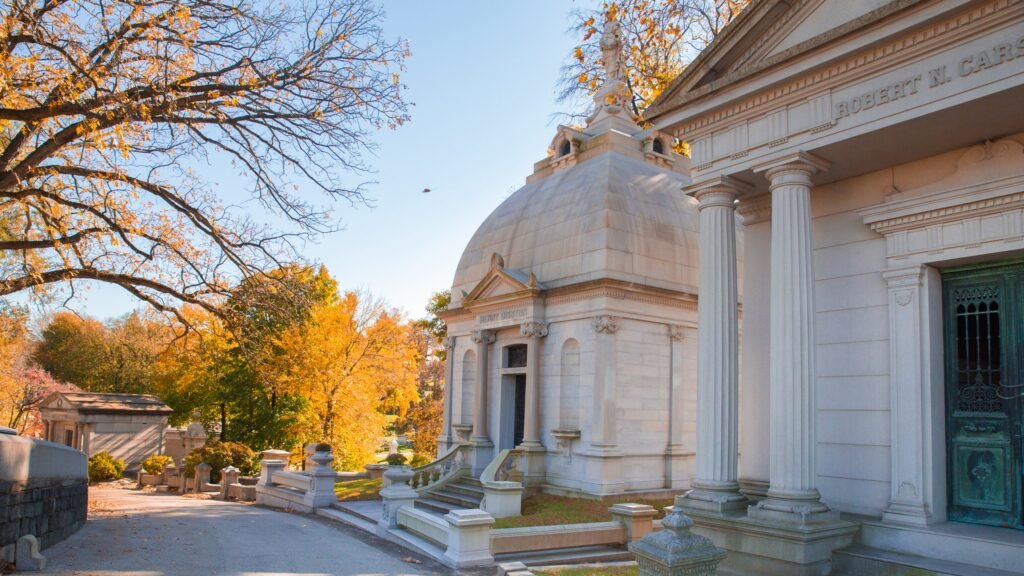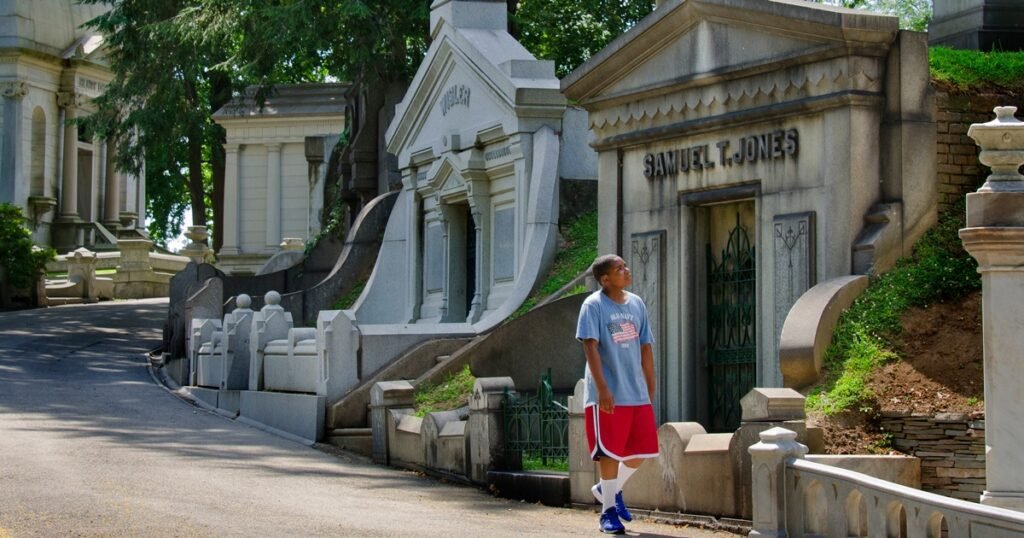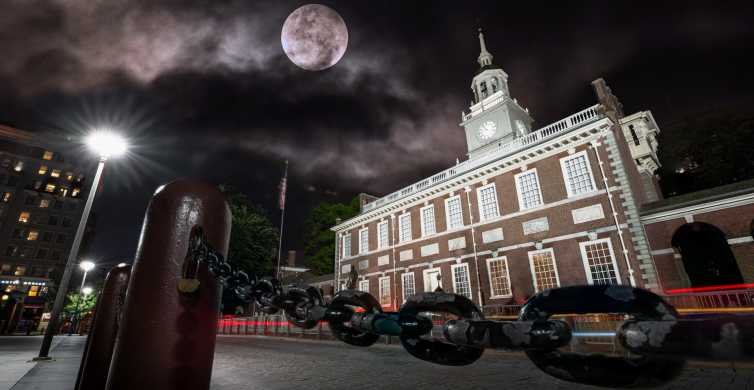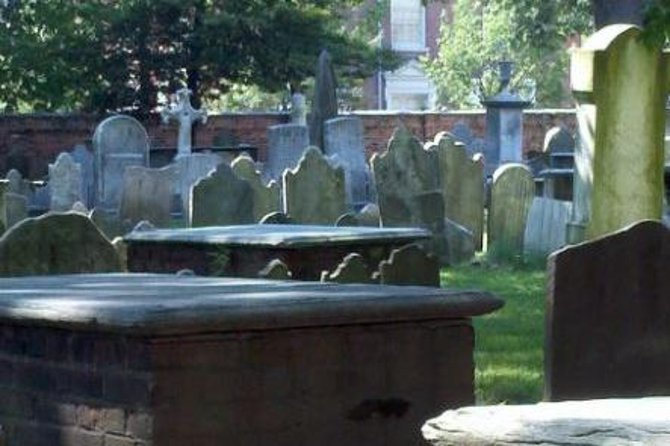Philadelphia, a city rich in history and culture, offers a plethora of options when it comes to exploring its historic cemetery tours. From the iconic Laurel Hill Cemetery, resting place of prominent figures such as Civil War generals and industrialists, to the eerie Eastern State Penitentiary that combines prison history with its own burial ground, there is no shortage of fascinating sites to discover. Embrace the opportunity to wander through beautifully landscaped grounds while immersing yourself in the captivating stories of those who shaped Philadelphia’s past. Whether you’re a history buff or simply intrigued by the mysteries of life and death, these cemetery tours are sure to leave a lasting impact on your visit to the City of Brotherly Love.

1. Mount Moriah Cemetery
– History and significance
Mount Moriah Cemetery, located in the southwest region of Philadelphia, has a rich history and great significance. Established in 1855, it served as a final resting place for many notable Philadelphians. The cemetery spans over 380 acres, making it one of the largest cemeteries in the city. It holds great historical value as it not only showcases the city’s architectural heritage but also serves as a reflection of Philadelphia’s diverse cultural and religious communities over the years.
– Tour options and highlights
When visiting Mount Moriah Cemetery, you have various tour options to explore this historic site. Guided tours conducted by knowledgeable experts provide in-depth insights into the cemetery’s history and notable individuals buried here. These tours often highlight the unique architectural elements of the tombstones and monuments, showcasing the different styles and artistic expressions of various eras in Philadelphia’s history. Additionally, self-guided tours are also available, allowing visitors to explore at their own pace and discover the cemetery’s hidden gems.
One of the highlights of a tour in Mount Moriah Cemetery is the Cemetery Gatehouse, an impressive Gothic Revival structure that provides a glimpse into the cemetery’s past. Another notable feature is the Civil War section, where many soldiers who fought in the war were laid to rest. Visiting this area can be a poignant experience, as it allows you to pay tribute to those who made sacrifices for their country.
– Accessibility and logistics
If you’re planning to visit Mount Moriah Cemetery, it’s important to note that the cemetery is spread across two different municipalities: Philadelphia and Yeadon. While the Philadelphia section is open to the public, the Yeadon section is currently closed due to ongoing restoration and preservation efforts. To ensure a smooth visit, it is recommended to check the cemetery’s website or contact the management for up-to-date information on visiting hours and any restrictions in place.
It is worth noting that Mount Moriah Cemetery is a vast location, so comfortable walking shoes and a map are essential for your visit. As with any historic cemetery, it is important to be respectful of the grounds and adhere to any guidelines or restrictions provided by the cemetery management. Taking photographs can be a wonderful way to preserve memories, but always ensure you do so with respect and sensitivity.
2. Laurel Hill Cemetery
– Historical background
Located in the East Falls neighborhood of Philadelphia, Laurel Hill Cemetery is known for its stunning landscape and historic significance. Established in 1836, it was one of the first rural garden cemeteries in the United States and quickly became a popular burial place for the city’s elite. The cemetery’s design was influenced by the Victorian Garden Movement, resulting in a picturesque and tranquil setting.
– Types of guided tours
Laurel Hill Cemetery offers a variety of guided tours, catering to different interests and preferences. From general overview tours to more specialized themes such as architecture, women’s history, and military history, there is something for everyone. The knowledgeable guides bring the stories of the cemetery to life, highlighting the notable individuals buried here and detailing the historical events that shaped Philadelphia’s past. These tours provide a deeper understanding and appreciation for both the cemetery and the city’s history.
If you prefer a more immersive experience, Laurel Hill Cemetery also offers themed tours where actors portray famous historical figures buried in the cemetery. This unique style of tour allows visitors to interact with the past and gain a deeper understanding of the people and events that shaped Philadelphia’s history.
– Special events and programs
Throughout the year, Laurel Hill Cemetery hosts a range of special events and programs that provide even more opportunities to explore and engage with this historic site. From guided sunset tours to photography workshops, there are numerous options to enhance your visit. Additionally, the cemetery regularly hosts concerts and outdoor movie nights, providing a unique and memorable experience in a picturesque setting.
For those with a passion for history and preservation, Laurel Hill Cemetery also offers volunteer and educational programs. These opportunities allow participants to contribute to the ongoing preservation efforts and learn more about the cemetery’s history and its role in Philadelphia’s cultural landscape.

3. Woodlands Cemetery
– Overview of the cemetery
Woodlands Cemetery, located in the University City neighborhood of Philadelphia, is a hidden gem that offers a peaceful escape from the bustling city. Founded in 1840, it encompasses 54 acres of beautiful landscape, including gardens, trees, and rolling hills. The cemetery’s purposeful focus on nature and landscape design sets it apart from other cemeteries in the city, making it a tranquil oasis for reflection and exploration.
– Guided tours and self-guided options
Woodlands Cemetery provides both guided tours and self-guided options for visitors to explore its grounds. Experienced guides offer a wealth of knowledge on the cemetery’s history and the notable individuals buried here. These tours often delve into the unique stories of those interred, highlighting their contributions to Philadelphia’s cultural, social, and political spheres.
If you prefer to explore at your own pace, self-guided tours are a fantastic option. The cemetery offers detailed maps that highlight notable gravesites and points of interest, allowing you to navigate the grounds independently. These maps can be obtained at the cemetery’s visitor center, ensuring you have all the information you need to make the most of your visit.
– Notable gravesites
Woodlands Cemetery is the resting place of many notable figures who have shaped Philadelphia’s history. Among them are renowned artist Thomas Eakins, known for his realistic paintings, and renowned architect Samuel Sloan, who designed several iconic buildings in Philadelphia. Additionally, the cemetery is the final resting place of numerous notable philanthropists, educators, and social reformers who left lasting legacies in the city.
One of the most visited gravesites in Woodlands Cemetery is that of Sarah Josepha Hale, the influential writer and editor who campaigned for making Thanksgiving a national holiday. Paying homage to these influential individuals allows visitors to gain a deeper appreciation for the impact they had on Philadelphia’s cultural, educational, and artistic landscape.
4. Old Pine Street Church Cemetery
– Historical context
Old Pine Street Church Cemetery, located in the Society Hill neighborhood, holds a significant place in Philadelphia’s history. The cemetery is an extension of the Old Pine Street Presbyterian Church, which was founded in 1768. As one of the oldest Presbyterian congregations in the city, the church and its neighboring cemetery bear witness to centuries of social, religious, and cultural changes.
– Guided tours and visitor information
Visitors to Old Pine Street Church Cemetery can enjoy guided tours that delve into the cemetery’s historical context and the stories of those buried here. These tours provide a unique perspective on the social and religious fabric of Philadelphia’s past, highlighting the roles of the church and its congregants in shaping the city.
To ensure a smooth visit, it is advisable to check the cemetery’s website or contact the church’s administration for any visitor restrictions or specific tour schedules. Being mindful of the church’s ongoing religious services and ceremonies is vital to maintaining a respectful visit.
– Notable interments
Old Pine Street Church Cemetery is the final resting place for several notable figures who played significant roles in Philadelphia’s history. Among them is the renowned surgeon Philip Syng Physick, considered the “father of American surgery.” Another notable interment is that of George Plitt, a Revolutionary War soldier who was awarded the Purple Heart for his bravery. Exploring these gravesites and learning about the lives of those buried here adds depth and meaning to your visit.

5. Christ Church Burial Ground
– Importance in American history
Christ Church Burial Ground, located in the Old City neighborhood of Philadelphia, holds immense historical importance. Established in 1719, it is the final resting place of numerous notable figures from the Revolutionary era, including several signers of the Declaration of Independence. The cemetery’s historical significance lies in its connection to these influential individuals and its role as a witness to key events in American history.
– Tour options and highlights
When visiting Christ Church Burial Ground, there are several tour options available to uncover the cemetery’s historical treasures. Guided tours led by knowledgeable experts provide insights into the lives and contributions of the notable individuals buried here. These tours offer a fascinating glimpse into the Revolutionary era and shed light on the early days of Philadelphia as the nation’s capital.
One of the highlights of a tour in Christ Church Burial Ground is the opportunity to see the grave of Benjamin Franklin, one of America’s founding fathers and a polymath. Franklin’s tombstone, with its simple inscription and the tradition of throwing pennies on the grave, reflects the reverence and admiration Americans have for this iconic figure.
– Benjamin Franklin’s grave
Benjamin Franklin’s grave is undoubtedly the most visited site within Christ Church Burial Ground. Known for his achievements as a writer, inventor, scientist, and diplomat, Franklin’s burial place has become a symbol of America’s intellectual and cultural heritage. Visitors can pay their respects to this influential figure by leaving a small penny on his grave, a tradition that symbolizes Franklin’s frugality and down-to-earth personality.
Exploring Christ Church Burial Ground allows you to connect with the early days of American history and gain a deeper understanding of the individuals who fought for independence and laid the foundation for the nation.
6. Presbyterians in Philadelphia
– Introduction to Presbyterian burial sites
Philadelphia has a rich Presbyterian heritage, and several burial sites throughout the city reflect the influence of this religious community. From historic churches to cemeteries, these sites provide insights into the Presbyterian presence in Philadelphia and its contributions to the city’s cultural and religious landscape.
– Key locations and guided tours
Key locations associated with the Presbyterian community include Old Pine Street Church Cemetery and First Presbyterian Church of Kensington. These sites offer guided tours that delve into the history and significance of the Presbyterian community in Philadelphia. Exploring these locations allows visitors to gain a deeper understanding of the religious and social fabric that shaped the city’s past.
The knowledgeable guides provide insights into the lives of notable figures within the Presbyterian community, shedding light on their contributions to Philadelphia’s educational, religious, and cultural spheres. These tours offer a unique perspective on the city’s history, showcasing the enduring influence of the Presbyterian community.
– Notable figures buried
Presbyterian burial sites in Philadelphia are the resting places of many individuals who made significant contributions to the city. Among them is Reverend Albert Barnes, the renowned art collector and educator who founded the Barnes Foundation. Another notable figure is Reverend George Duffield, who played a crucial role in shaping the Presbyterian community in Philadelphia during the Revolutionary era.
Visiting these gravesites provides an opportunity to reflect on the influence and impact of Presbyterian individuals in shaping Philadelphia’s history and cultural identity.

7. Society Hill’s Historic Cemeteries
– Overview of Society Hill district
Society Hill, located in Philadelphia’s historic district, is a neighborhood steeped in history and charm. With its cobblestone streets, Federal-style architecture, and well-preserved colonial buildings, it provides a glimpse into Philadelphia’s past. Amidst the cobblestone pathways and tree-lined streets of Society Hill lie several historic cemeteries, each with its distinct character and stories to tell.
– Visiting the cemeteries in the area
Exploring the historic cemeteries of Society Hill offers visitors a unique opportunity to delve into Philadelphia’s past. From the picturesque ambiance of Mount Vernon Cemetery to the well-manicured grounds of St. Peter’s Episcopal Churchyard, each cemetery provides a serene setting for contemplation and reflection.
Visitors can embark on self-guided tours of these cemeteries, allowing them to explore at their own pace and discover hidden gems. Maps and information about notable individuals buried in these cemeteries can typically be obtained from the respective cemetery’s visitor center or through online resources. Respectful and mindful exploration of these burial grounds contributes to the preservation of Philadelphia’s history and cultural heritage.
– Notable tombstones and history
Society Hill’s historic cemeteries are home to many notable tombstones that reflect the city’s rich history. For example, St. Peter’s Episcopal Churchyard is the final resting place of Commodore Stephen Decatur, a hero of the War of 1812. Mount Vernon Cemetery is notable for its connection to the abolitionist movement, as many prominent figures who fought against slavery are buried here.
Exploring these burial grounds offers an opportunity to pay homage to these influential individuals and gain a deeper understanding of their contributions to Philadelphia’s cultural, social, and political fabric.
8. Monument Cemetery
– History and decline
Monument Cemetery, located in the Kensington neighborhood of Philadelphia, has a fascinating history and a tragic decline. Established in 1837, it was intended to be a beautiful final resting place for Philadelphia’s elite. The cemetery earned its name from the grand monument erected in honor of General Hugh Mercer, a hero of the American Revolution.
However, over the years, Monument Cemetery fell into disrepair and faced numerous challenges, including vandalism, neglect, and financial difficulties. The cemetery eventually fell into a state of disarray, making it a haunting reflection of a forgotten past.
– Efforts to preserve and restore
While Monument Cemetery may no longer be an active burial ground, there are ongoing efforts to preserve and restore this historic site. Local preservation organizations and community volunteers have been working tirelessly to clear overgrown vegetation, restore damaged tombstones, and uncover the cemetery’s hidden historical treasures.
Through the dedication and passion of these individuals, Monument Cemetery is slowly being brought back to life, serving as a testament to the community’s commitment to honoring the past and preserving Philadelphia’s heritage.
– Virtual tours and online resources
Given the current state of Monument Cemetery, physical visits may not be possible or advisable. However, virtual tours and online resources provide an opportunity to explore this unique historic site from the comfort of your own home. Through virtual tours, informative videos, and historical archives, you can learn about the cemetery’s history, significant individuals buried here, and ongoing preservation efforts.
Exploring Monument Cemetery’s online resources can be a great way to contribute to its preservation and raise awareness about the importance of safeguarding Philadelphia’s historic landmarks.

9. Odd Fellows Cemetery
– Background and historical development
Located in the Fern Rock neighborhood of Philadelphia, Odd Fellows Cemetery has a fascinating background and historical development. Established in 1849, it was originally created as a burial ground for the Independent Order of Odd Fellows, a fraternal organization focused on providing support and assistance to members in need.
As the cemetery expanded, it began to serve as a final resting place for members of the wider community. Odd Fellows Cemetery played a significant role in providing burial options to diverse populations, including African Americans, during times when racial segregation was prevalent in many cemeteries.
– Visiting information and tour options
Visitors to Odd Fellows Cemetery can explore its grounds and discover the stories of those buried here. As a still-active cemetery, it’s important to be respectful of ongoing burials and mourning families during your visit. Checking the cemetery’s website or contacting the administration for visitor information and guidelines is advised to ensure a respectful and seamless visit.
Guided tours of Odd Fellows Cemetery may also be available, providing insights into the cemetery’s history, its notable gravesites, and the cultural significance of the burial practices within the Independent Order of Odd Fellows.
– Preservation efforts
Preserving the historical integrity of Odd Fellows Cemetery is a priority for the cemetery’s administration and the wider community. Ongoing restoration efforts are focused on repairing damaged tombstones, maintaining the grounds, and ensuring the cemetery remains a place of dignity and respect for the departed.
These preservation efforts not only honor the rich history of Odd Fellows Cemetery but also serve as a reminder of the community’s commitment to preserving Philadelphia’s cultural heritage and ensuring that future generations have access to this important historical site.
10. Philadelphia’s Potter’s Fields
– Introduction to Potter’s Fields
Potter’s Fields, historically known as burial grounds for the indigent and unidentified individuals, played a crucial role in Philadelphia’s history. These burial grounds provided a final resting place for those who could not afford private burial plots or lacked recognition in society.
– Location and historical context
Philadelphia’s Potter’s Fields were primarily located outside the central city area, reflecting the social divisions and disparities prevalent during their time of use. These burial grounds were often sparse, with minimal markers or tombstones, making it difficult to trace specific individuals buried there.
The existence of Potter’s Fields is a somber reminder of the challenges faced by marginalized and disadvantaged individuals throughout Philadelphia’s history. Exploring these sites offers an opportunity for reflection and remembrance of those who lived on the fringes of society.
– Commemoration and remembrance
While the exact locations and extents of Philadelphia’s Potter’s Fields may be challenging to identify, efforts have been made to commemorate and honor the individuals buried within them. Memorials and plaques have been erected in certain locations to acknowledge the existence and significance of these burial grounds.
Visiting these commemorations can provide a poignant reminder of the importance of inclusivity and social justice in honoring the memory of all individuals, regardless of their socioeconomic status or societal standing.
In conclusion, Philadelphia’s historic cemeteries offer a unique and captivating glimpse into the city’s past. Whether you choose to explore the grandeur of Mount Moriah Cemetery, immerse yourself in the stories of Laurel Hill Cemetery, or wander through the serene landscapes of Woodlands Cemetery, each burial ground holds its own treasures and tales waiting to be discovered. From the influentildeational figures buried in Christ Church Burial Ground to the mesmerizing beauty of Society Hill’s historic cemeteries, Philadelphia’s historic cemeteries provide a window into the city’s diverse history and cultural heritage. So, grab your walking shoes, a map, and a spirit of curiosity, and embark on a journey of exploration through Philadelphia’s fascinating past.
